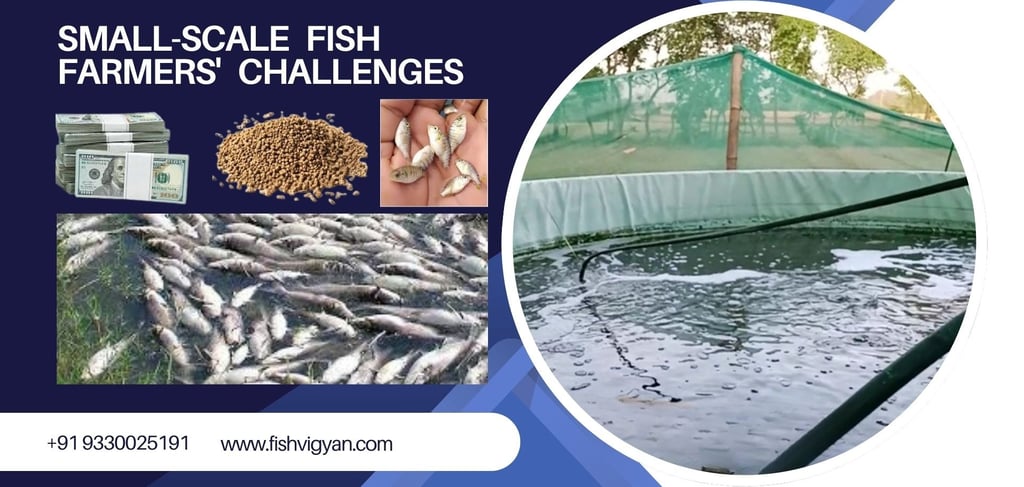Challenges Faced by Small-Scale Fish Farmers
**Fish farming**, or aquaculture, is essential for global food supply and local economies. Small-scale fish farmers contribute to fresh fish production, employment, and sustainability but face significant challenges. This article highlights these challenges and explores solutions to enhance their productivity and profitability.


1. Limited Access to Capital and Funding
One of the biggest challenges for small-scale fish farmers is the lack of financial support. Fish farming requires significant investment in infrastructure, equipment, quality fish feed, and maintenance. Unfortunately, many farmers struggle to obtain loans or funding from banks and financial institutions due to a lack of collateral, high-interest rates, and bureaucratic hurdles.
Potential Solutions
Governments and financial institutions should create special loan programs with low interest rates and flexible repayment terms for small fish farmers.
Encouraging microfinance institutions and cooperatives to provide financial aid.
Training farmers on financial literacy to improve their ability to manage funds efficiently.
2. High Cost of Fish Feed
Fish feed accounts for 50-70% of the total production cost in fish farming. The high cost of commercial feed makes it difficult for small-scale farmers to maintain profitability. In many regions, farmers rely on expensive imported feed, which further increases operational costs.
Potential Solutions
Promoting the use of locally available feed ingredients such as rice bran, maize, and cassava.
Encouraging research and development in cost-effective feed alternatives, including insect-based and plant-based feeds.
Training farmers on producing homemade fish feed with balanced nutrition.
3. Poor Water Quality Management
Water quality is essential for the health and growth of fish. Poor water management can lead to disease outbreaks, slow growth rates, and high mortality rates. Common water quality issues include low oxygen levels, excessive ammonia, and pH imbalances.
Potential Solutions
Regular monitoring of water parameters such as pH, dissolved oxygen, and ammonia levels.
Implementing biofiltration systems to improve water quality.
Promoting sustainable pond management techniques such as proper aeration and periodic water exchange.
4. Limited Access to Quality Fingerlings
Fingerlings (young fish) play a crucial role in fish farming. Poor-quality or diseased fingerlings result in slow growth rates, high mortality, and low yields. Many small-scale farmers struggle to access reliable hatcheries or face high costs when purchasing quality fingerlings.
Potential Solutions
Establishing government-supported hatcheries to provide high-quality, affordable fingerlings.
Encouraging farmers to form cooperatives to collectively purchase fingerlings at discounted rates.
Training farmers on breeding techniques to reduce dependency on external hatcheries.
5. Disease Outbreaks and Fish Mortality
Disease outbreaks can cause significant financial losses in fish farming. Common fish diseases include bacterial infections, parasitic infestations, and viral outbreaks. Many small-scale farmers lack knowledge about disease prevention and treatment, leading to high mortality rates.
Potential Solutions
Regular vaccination and proper disease prevention measures.
Training farmers on early disease detection and biosecurity measures.
Implementing proper feeding and water management practices to boost fish immunity.
6. Climate Change and Extreme Weather Conditions
Climate change has a direct impact on fish farming, affecting water temperature, oxygen levels, and fish health. Extreme weather conditions such as floods, droughts, and storms can destroy fish ponds and cages, leading to massive losses.
Potential Solutions
Encouraging climate-resilient aquaculture techniques such as deep-water ponds and integrated farming systems.
Providing insurance coverage for fish farmers to mitigate losses due to natural disasters.
Educating farmers on adapting to climate variations through better pond management.
7. Market Access and Price Fluctuations
Many small-scale fish farmers struggle with selling their products at fair prices. Middlemen often exploit them by offering low prices, and market demand fluctuates due to seasonal trends.
Establishing farmers' cooperatives to negotiate better prices and eliminate middlemen.
Improving cold storage and transportation infrastructure to extend fish shelf life.
Promoting direct sales through online platforms and local farmers' markets.
8. Lack of Technical Knowledge and Training
Potential Solutions
Many small-scale fish farmers rely on traditional methods that may not be efficient. A lack of access to training and modern aquaculture techniques results in lower productivity and increased losses.
Potential Solutions
Fish Vigyan provides both online and offline training programs designed specifically for small-and large-scale fish farmers. These programs cover modern aquaculture techniques, water quality management, disease prevention, and cost-effective feeding practices.
Farmers can also explore other available training opportunities, such as government-sponsored workshops and digital platforms offering aquaculture education.
Encouraging knowledge-sharing through farmer cooperatives and industry forums to create a more informed and skilled farming community.
9. Government Policies and Regulatory Challenges
Many small-scale fish farmers face bureaucratic challenges when trying to obtain permits, licenses, and subsidies. Complex regulations often discourage new entrants into the fish farming industry.
10. Predation and Theft
Small-scale fish farmers often face losses due to predators such as birds, otters, and snakes. Additionally, fish theft is a major concern, especially in regions with high poverty levels.
Potential Solutions
Installing protective nets and fencing around fish ponds.
Using fish enclosures or cages to prevent predation.
Implementing community-based security measures to prevent theft.
Conclusion
Small-scale fish farmers play a crucial role in the aquaculture industry, but they face multiple challenges that hinder their growth and profitability. Addressing these challenges requires a combined effort from governments, NGOs, financial institutions, and the farmers themselves.
By improving access to funding, providing quality fish feed, ensuring water quality management, and promoting market linkages, we can empower small-scale fish farmers to thrive. Sustainable fish farming practices will not only benefit the farmers but also contribute to global food security and economic growth.
For more insights on fish farming and sustainable aquaculture practices, visit Fish Vigyan
Simplifying the licensing process for small fish farmers
Providing clear guidelines and transparent policies for sustainable aquaculture.
Encouraging public-private partnerships to support small-scale aquaculture development
